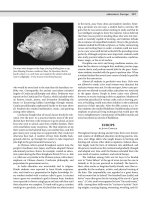Encyclopedia of society and culture in the ancient world ( PDFDrive ) 193
Bạn đang xem bản rút gọn của tài liệu. Xem và tải ngay bản đầy đủ của tài liệu tại đây (89.13 KB, 1 trang )
164
calendars and clocks: Africa
View of the royal tombs at Meroë, ancient city of northeastern Africa in present-day Sudan; the entrances face east, toward the rising star Sirius, a
positioning that suggests that they served as a type of calendar. (Courtesy of the Oriental Institute of the University of Chicago)
expertise in astronomy, for the progression of days, months,
seasons, and years represents the movement and rotation of
the earth in relation to the sun and moon. Archaeologists who
study these matters refer to their field of inquiry as archaeoastronomy. These scholars are interested in archaeological
evidence of astronomical observations that ancient societies
made to keep track of time.
One of their major findings was the discovery of a calendar system used by the Borana of southern Ethiopia and
northwest Kenya. The Borana, ignoring the sun, developed
a calendar regulated by seven stars and star groups observed
in conjunction with the phases of the moon. In 1978 archaeologists discovered at a site near Lake Turkana in Kenya a
cluster of 19 stone pillars. The name of the site is Namoratunga, meaning “stone people.” Writing carved on the stones
provides evidence that the pillars date to 300 b.c.e.
The Borana measured time using a 354-day lunar year
with 12 months; they did not keep track of weeks. Every three
years a leap month was added so that the lunar years remained
consistent with the 365-day solar year. The Borana relied on
seven stars or star groups: Their modern names are Triangulum, Pleiades, Aldebaran, Bellatrix, Orion’s Belt, Saiph, and
Sirius. The new year began when a new moon was observed
in conjunction with Triangulum; the next month began when
the new moon was seen in conjunction with the Pleiades, and
so on. The Borana had names for only 27 days of the month,
even though the month could be as long as 30 days; when they
arrived at the end of the list after 27 days, they started over
with the name at the beginning of the list.
Astronomers and archaeologists, though, have struggled with how the Borana knew that the specific star systems
were near the moon, because some of these stars cannot be
seen when they are too close to a new moon. Some researchers believe that the 19 Namoratunga pillars were intended to
mark the positions of these stars, allowing the stars’ placement in the sky to be known even when the stars themselves
could not be seen clearly. Using statistical analyses, archaeologists have determined that the possibility is less than a
half a percentage point that the pillars could have marked
the stars’ locations by chance. For them, this is strong evidence that the cluster of pillars was an astronomical observatory and hence a calendar.
Structures that function like calendars have also been
found in other parts of ancient Africa. In central Sudan
the kingdom of Kush flourished from about 1000 to 100
b.c.e. The area features numerous pyramids, similar to the
pyramids found in ancient Egypt. The entrances to these
pyramids face east, directly at the rising star Sirius. Th is
positioning suggests that they served as a type of calendar.
In numerous places in Tanzania archaeologists have discovered cave drawings of precisely drawn circles. The circles are
concentric and exactly spaced. The number of circles ranges
from one to 29 or 30—numbers that suggest some connection with the lunar cycle.
Little is known about timekeeping in ancient Africa. Like
most cultures throughout the world, the ancient Africans
probably kept track of time throughout the day with some sort
of basic sundial. A sundial can consist of little more than a









